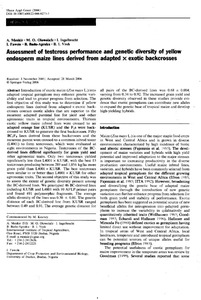| dc.contributor.author | Menkir, A. |
| dc.contributor.author | Olowolafe, M.O. |
| dc.contributor.author | Ingelbrecht, I.L. |
| dc.contributor.author | Fawole, I. |
| dc.contributor.author | Badu-Apraku, B. |
| dc.contributor.author | Vroh Bi, Irie |
| dc.date.accessioned | 2019-12-04T11:18:34Z |
| dc.date.available | 2019-12-04T11:18:34Z |
| dc.date.issued | 2006 |
| dc.identifier.citation | Menkir, A., Olowolafe, M.O., Ingelbrecht, I., Fawole, I., Badu-Apraku, B. & Vroh, B.I. (2006). Assessment of testcross performance and genetic diversity of yellow endosperm maize lines derived from adapted× exotic backcrosses. Theoretical and Applied Genetics, 113(1), 90-99. |
| dc.identifier.uri | https://hdl.handle.net/20.500.12478/3254 |
| dc.description.abstract | Introduction of exotic maize (Zea mays L.) into adapted tropical germplasm may enhance genetic variability and lead to greater progress from selection. The first objective of this study was to determine if yellow endosperm lines derived from adapted x exotic backcrosses contain exotic alleles that are superior to the recurrent adapted parental line for yield and other agronomic traits in tropical environments. Thirteen exotic yellow maize inbred lines were crossed to an adapted orange line (KUSR) and the F1s were backcrossed to KUSR to generate the first backcrosses. Fifty BC1F4 lines derived from these backcrosses and the recurrent parent were crossed to a common inbred tester (L4001) to form testcrosses, which were evaluated at eight environments in Nigeria. Testcrosses of the BC-derived lines differed significantly for grain yield and other agronomic traits. Only two testcrosses yielded significantly less than L4001 x KUSR, with the best 15 testcrosses producing between 289 and 1,056 kg/ha more grain yield than L4001 x KUSR. The best testcrosses were similar to or better than L4001 x KUSR for other agronomic traits. The second objective of this study was to assess the extent of genetic diversity present among the BC-derived lines. We genotyped 46 BC-derived lines including KUSR and L4001 with 10 AFLP primer pairs and found 491 polymorphic fragments. The average allelic diversity of the lines was 0.30 +/- 0.01. The genetic distance of each BC-derived line from KUSR ranged between 0.49 and 0.91. The average genetic distance for all pairs of the BC-derived lines was 0.68 +/- 0.004, varying from 0.34 to 0.92. The increased grain yield and genetic diversity observed in these studies provide evidence that exotic germplasm can contribute new alleles to expand the genetic base of tropical maize and develop high-yielding hybrids. |
| dc.language.iso | en |
| dc.subject | Inbred Line |
| dc.subject | Recurrent Parent |
| dc.subject | Maize Inbred Line |
| dc.subject | Gray Leaf Spot |
| dc.subject | Maize Streak Virus |
| dc.title | Assessment of testcross performance and genetic diversity of yellow endosperm maize lines derived from adapted x exotic backcrosses |
| dc.type | Journal Article |
| dc.description.version | Peer Review |
| cg.contributor.affiliation | International Institute of Tropical Agriculture |
| cg.contributor.affiliation | University of Ibadan |
| cg.coverage.region | Acp |
| cg.coverage.region | Asia |
| cg.coverage.region | Africa |
| cg.coverage.region | North America |
| cg.coverage.region | Southeast Asia |
| cg.coverage.region | West Africa |
| cg.coverage.country | United States |
| cg.coverage.country | Thailand |
| cg.coverage.country | Nigeria |
| cg.isijournal | ISI Journal |
| cg.authorship.types | CGIAR and developing country institute |
| cg.iitasubject | Plant Breeding |
| cg.iitasubject | Maize |
| cg.iitasubject | Plant Diseases |
| cg.iitasubject | Impact Assessment |
| cg.iitasubject | Genetic Improvement |
| cg.accessibilitystatus | Limited Access |
| local.dspaceid | 94928 |
| cg.identifier.doi | http://dx.doi.org/10.1007/s00122-006-0275-5 |

